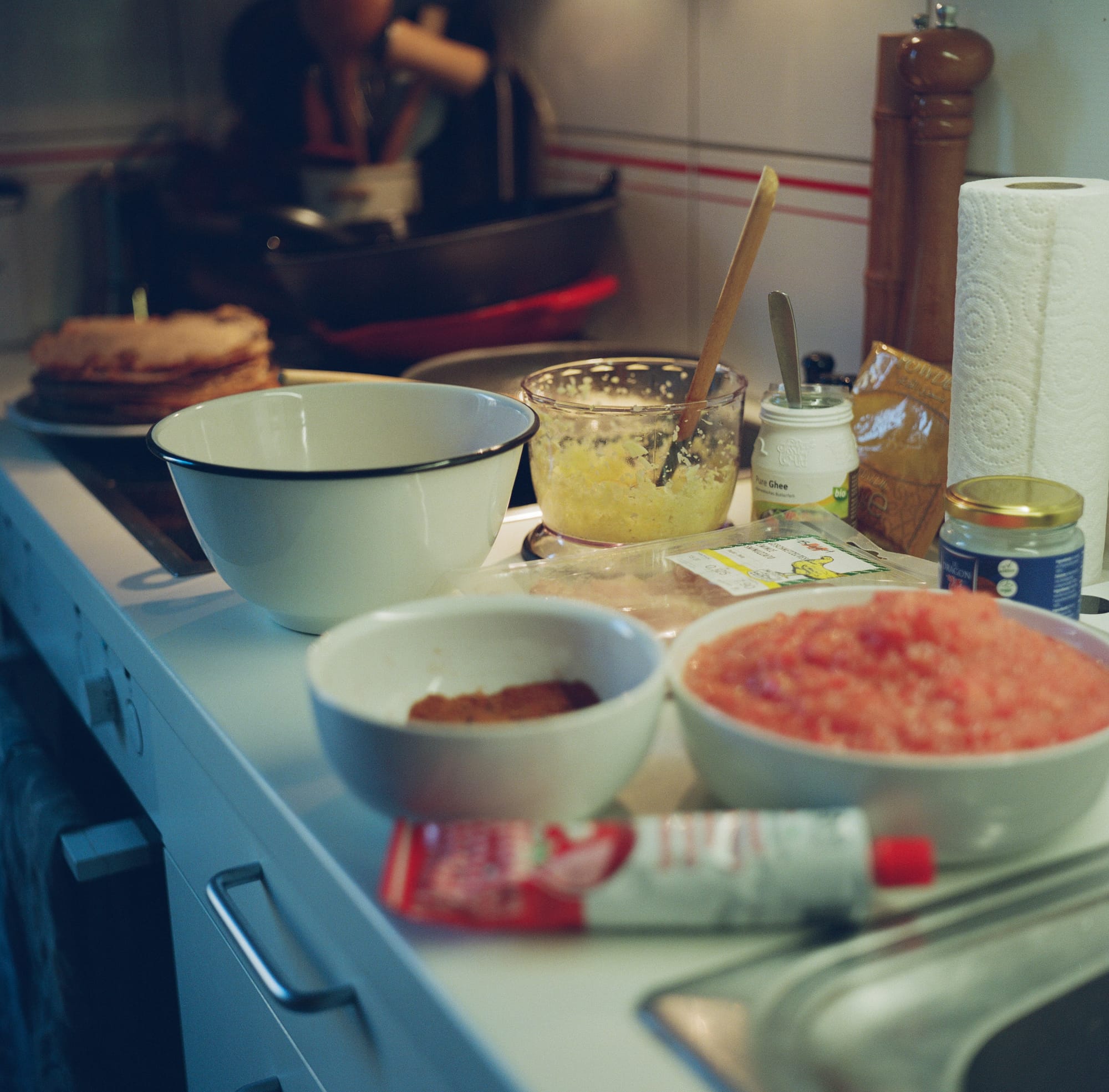What to eat ERITREA 🇪🇷 Zigni derho with injera
In Mussolini's la piccola Roma, the Italian influence became a permanent fixture in terms of architecture... zigni... travelled back to the Italian homeland as zighini.

Zigni derho with injera
Published May 30, 2025 · by Amanda Rivkin Häsler
Zigni, a popular stew in Eritrea made of meat, tomatoes, onions and berbere spices, has no clear origin story. This is due in part to conflict, colonialism and a certain lack of stability. Uncertainty disrupts clarity of lineage of everything, from families to food.
As a dish, the meat can be many things: beef, lamb, goat or chicken, depending on incomes and the availability of essential ingredients. Usually, the cooked zigni stew is placed on a plate of injera, the unleavened bread made of teff flour known for its spongy quality and enough holes to make one think Swiss cheese is a solid brick. It is then consumed with the right hand, tearing off a bit of injera and using it to scoop up the portion of stew closest to where one is seated around the communal bowl.
Whereas Ethiopians use the Amharic names for very similar dishes, Eritreans rely on the Tigrinya names. There are other distinctions too, such as the less seasoned butter Eritreans prefer over Ethiopians' niter kibbeh, resulting in a lighter dish (we used ghee for both countries due to availability of ingredients). Eritreans call their version of clarified butter t'esmi, which is similar to ghee but seasoned with herbs and spices as well.
Italian colonialism is credited with the introduction of tomatoes into the dish, though this too is uncertain. While certainly the early twentieth century architectural influence of Italy is all over the Eritrean capital, Asmara, and pasta is available, the flow of influences by no means went one way, with zigni-like stew ending up in pizza pockets and other curious concoctions in the Italian capital of Rome. The addition of curry and cumin into zigni is a nod to the geography of Eritrea on the Horn of Africa and the proximity to Middle Eastern cultures and spice bazaars.

In traditional Eritrean households, the task of cooking falls on the women, much as it does elsewhere in the world. The arrival of Italy's fascist dictator Benito Mussolini in 1922 did little to alter patriarchal traditions, especially as he dubbed Asmara his "Second Roman Empire". Its geography made it an ideal location for Italy's imperial pursuits in Africa, a reconquest of the Holy Roman Empire.
In Mussolini's la piccola Roma, the Italian influence became a permanent fixture in terms of architecture, while the population of Asmara ballooned to be half Italian in 1939. By the time of his death and the subsequent postwar anticolonial movements took hold, it was the buildings that stood the test of time and zigni which travelled back to the Italian homeland as zighini.

The Italians though were not the first to colonize the country but rather followed a long line of regional powers that included the Ottomans, the Egyptians, the British and the Ethiopians. After thirty years of conflict with Haile Selassie's Ethiopian Army, Eritrea declared independence in 1991.
The country's political history has been brutal to its civilians. In more recent times, the government of Isaias Afwerki has ruled with an iron fist, isolating the country from much of the world. Afwerki stands accused of human rights violations including forced labor, arbitrary arrests and detentions, disappearances, torture and an absence of freedom of expression. Widely viewed as a pariah state under UN sanctions, the country is hard to access as a journalist or tourist.
As the leader of an ostensible People's Liberation Front, despite the authoritarianism, Afwerki won himself left-leaning friends in the West among those who fetishize revolutionary struggle no matter the cost, especially if they themselves do not have to suffer or bear the consequences. So too Afwerki has his friends among Switzerland's left-leaning intelligentsia which has brought many Eritreans to the country over the years.
What some on the Western left might label liberation, a more critical eye might discern the white savior complex of Swiss-style para-colonialism in pet revolutionary projects in desperately poor nations. Regardless of how the origin of this immigration began, it is like most all things by no means monolithic. Many Eritreans in Switzerland are now first and second generation Swiss, known as secondos, with citizenship, voting rights, military service and Swiss education under their belts.
Nonetheless, Eritrea's authoritarian government and the disputes of exiles have been known to spill out into the streets of Switzerland such as when scuffles broke out in the last few years in the suburbs of Zürich. As the public broadcaster Swiss Info noted at the time, the clashes left 12 injured but also took place in Norway and Israel on the same day, as the country marked the anniversary of the start of the war of independence in 1961 and Afwerki's 30 years in power. It is unlikely we will know more about the origins of the national dish as long as the dust is unsettled on the broader narrative of the nation and its people.
Recipe
Ingredients:
For the injera (step 1):
1.5 cups of teff flour
Half a cup of buckwheat flour
7 grams or one packet of dried yeast
1 tablespoon sea salt
1 teaspoon baking soda
2.5 cups distilled or natural drinking water (such as Vittel) with little to no fluoride or chlorine
1 tablespoon apple cider vinegar
For the second part of the injera mixture (steps 3-4):
One cup boiling water
Sunflower seed or any other neutral cooking oil
For the berbere spice mixture (step 2):
4 black peppercorns
3 black cardamon pods
2 teaspoons cumin seeds
1 clove
Half teaspoon fennel seeds
4 tablespoons ground hot chili pepper
3 tablespoons hot paprika
3 teaspoons coriander
1 teaspoon salt
1 teaspoon turmeric
Half teaspoon cinnamon
For the zigni derho:
8 small white onions
70-100 grams of ghee (two heaping tablespoons)
11 small tomatoes
Small piece of fresh ginger
5 large cloves of garlic
1 tablespoon of tomato paste
500 grams of sliced chicken
2 eggs
Step 1: Begin the day before for the injera. Mix the dry ingredients. Then add water and apple cider vinegar. Combine and cover loosely with plastic, allow to sit overnight in a warm but dry place. Do not refrigerate.
Step 2: The next morning, make your berbere spice mix by first heating all the seeds for one minute and grinding together with a mortar and pestle. Then combine with all remaining powdered ingredients. Set aside. Do not rinse pan nor return it to heat.
Step 3: Returning to the injera, combine one cup of boiling water with half a cup of the injera mixture. Once paste-like, return to the larger injera mixture and combine again using a wooden spoon. Cover the injera batter again loosely with plastic.
Step 4: Coat a non-stick pan with a thin layer of oil. Ladle the injera mixture into the pan on a medium-high heat, tilting the pan after pouring to spread the injera batter as thin as possible across the surface of the pan. When surface area begins to bubble, cover with a lid to steam. Remove from heat with a spatula after 1-2 minutes and set aside, using paper towels as needed to absorb any excess oil and separate the injera. Repeat until the injera mixture is gone and all of the batter becomes injera.
Injera should have a thin consistency between a crepe and a pancake. After all the injera is made, remove any layers of paper towels from cooked injera and transfer to a new plate or bowl, stacked one on top of the other. This is to prevent the injera from sticking to the paper towels.
Step 5: Peel and dice the onions.
Step 6: Return the pan that was used to heat the spices to heat. Place on low to medium heat. Add approximately 70 grams of ghee (or clarified butter if one has access to it) or two heaping tablespoons to the pan. Let melt before adding the onions. Stir periodically.
Step 7: While the onions brown in ghee on low to medium heat, puree the tomatoes using a food processor. Remove from food processor and set aside.
Step 8: Remove exterior from ginger and peel the cloves of garlic. Combine into a purée in the food processor and set aside.
Step 9: When the onions begin to brown, add the berbere spice mix and combine, stirring with a wooden spoon. Let cook another five minutes or so.
Step 10: Add the pureed tomatoes and garlic and ginger. Stir and add tomato paste. Stir some more. Add the chicken, stir, turn down heat and cover.
Step 11: Soft boil two eggs. Run cold water over, let cool and peel off shell. Add to the zigni as a whole egg.
Step 12: Arrange injera in a wide bowl for serving. Roll remaining injera and set aside for scooping up zigni derho. Pour the zigni derho on top. Enjoy!
Tips, tricks and notes:
For ghee and teff flour, try Alnatura, the Swiss supermarket chain. As teff flour was sold out at all the locations in Bern when we prepared to make this, I ended up ordering from a website called Kanela.
We took some heat for our injera (only this time we found teff flour not just flakes!) when we posted Ethiopia’s strikingly similar national dish, doro wat with injera. The quality and consistency were very good for home-cooked injera in a Swiss kitchen. So, here’s hoping we do not tick off World War III by replicating our results from before here. Or perhaps, we do better and unite Eritreans and Ethiopians once and for all in slamming our Westernization of their most delectable national dishes! We can take the heat if it brings folks together.
Learn where to eat Eritrean food in Switzerland.
Follow our social media pages @swissglobaldining on Instagram, TikTok and YouTube